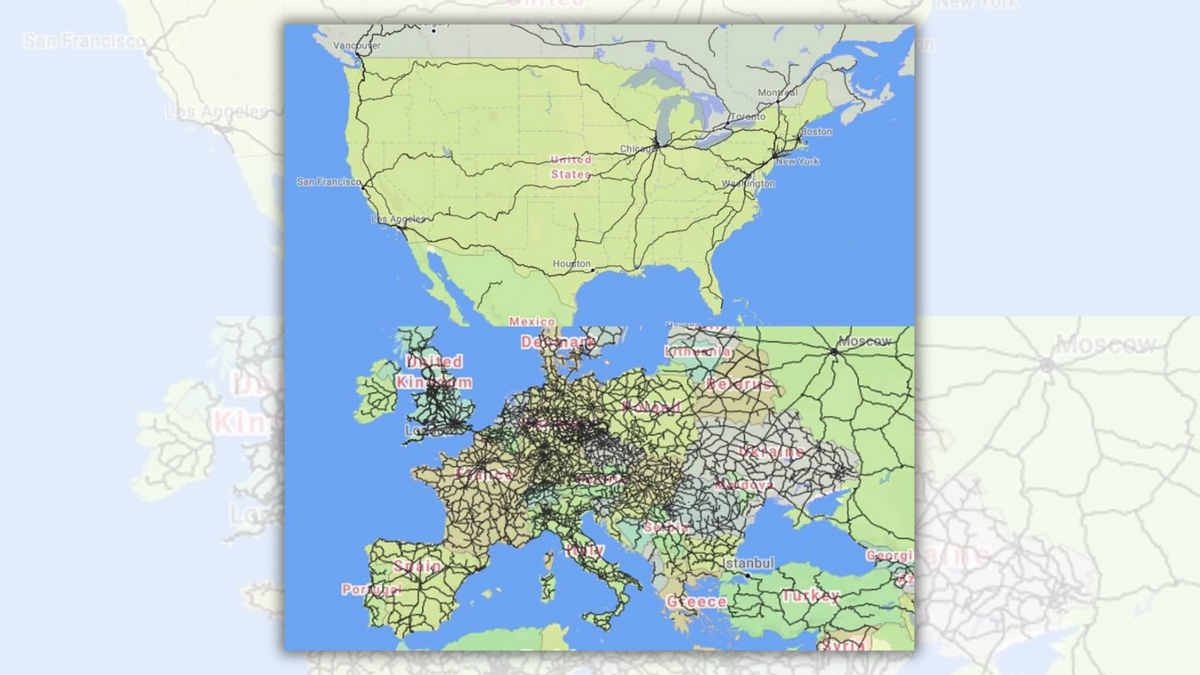These Maps Claim to Show Passenger Trains in US vs. Europe. Here Are the Facts

On April 15, 2024, a Facebook page titled The sound of Train posted an image of two maps purporting to compare passenger train lines in the United States and Europe (archived):
https://www.facebook.com/permalink.php?story_fbid=pfbid02xKwLTLem3nt89eWpXHoxoyRP1napBHBCjyYAM2mcpDdXxFhy3LC37bfGCEMgYtmHl&id=100043574755657
The post had gained 117,000 reactions, 21,800 comments and 44,000 reshares as of this writing. The same image appeared on Reddit in 2023, and also went viral. "In Germany, trains are used even for [sic] go from bathroom to kitchen," one user quipped.
Although the maps conveyed a generally accurate impression of the differences in size and density between the U.S. passenger train system and Europe's, the U.S. map did not include all regional and commuter passenger train lines, so the comparison was slightly unbalanced. The European map was an accurate representation of reality.
It is true that, compared to Europe, the U.S.'s passenger train system is underdeveloped. More accurately, it has been severely degraded over the decades, as many lines across the country have fallen into disuse since the 1960s, according to a 2019 post by The Greater Greater Washington (a website that advocates for better urbanization in the Washington, D.C., area) based on data from the National Association of Rail Passengers.
In the same period, Europe opened many new passenger train lines at the city and regional level, connecting large cities within countries and even across borders. In 1981, the French government opened Europe's first high-speed train line between Paris and Lyon. That technology expanded across the continent with AVE, connecting major cities in Spain, and the Eurostar, which connects London to Paris, Brussels and Amsterdam. As of 2024, trains of all speeds connected Munich to Prague, Marseille to Barcelona, and Vienna to Rome.
The U.S. map in the image accurately shows Amtrak's map of trains, which we found on Amtrak's website. Amtrak is a national network of trains that connect cities over long distances.
Meanwhile, we compared the viral European map to national railroad maps and realized that it includes not only long-distance lines, but also regional ones. In part, that is why that map has considerably more lines compared to the U.S.'s.
In other words, a fair comparison between the two systems would include all regional U.S. lines such as the Long Island Rail Road and Metro-North (the nation's largest networks with a combined 136 million rides each year); the NJ Transit Rail Operations, which links New York City to Philadelphia, and the Southeastern Pennsylvania Transportation Authority — better known as SEPTA — around Philadelphia. Other such lines include Caltrain around San Francisco and Denver's RTD.
Even when it was most used in the 1910s and 1920s, America's passenger train network displayed stark differences between regions. Eastern cities are closer, denser, and more amenable to railroad connection, while, in the west, agglomerations are more distant from each other. Still, travelers used the train widely a century ago.
All of this changed starting in 1929 due to multiple reasons: First, the Wall Street crash of 1929 sparked the Great Depression, which made mid-and long-distance travel less affordable to people with economic problems. At the same time, Ford Motor Company brought the mass production of cars to the market, and, by that year, 23 million automobiles were on the road for a population of 123 million people. The subsequent urbanization changed the transportation market, making it more convenient for households to own one or more cars. Then came airplane travel. Little by little, the U.S. economy deprioritized the train system.
But the success of local and regional train lines in the northeast of the U.S. might provide a clue to the evolving transportation needs of the country. Experts say creating pedestrian-friendly streets and roads and investing in public transportation helps decongest cities and highways. U.S. President Joe Biden announced in late 2023 a plan to develop new train lines and technology, including high-speed rail for passengers.
Meanwhile, in Europe, low-cost airlines have upended the train market. While many passengers would rather travel by rail, the costs of train tickets are often higher compared to widely accessible plane tickets. There, too, European politicians are seeking solutions to make train travel more attractive than air travel to most passengers.
Sources:
A Complete History of Trains in the United States | U.S. Train Guide. https://www.volocars.com/blog/complete-history-of-trains. Accessed 24 Apr. 2024.
Alpert, TransitHistoryBy David, et al. The Evolution of Amtrak, 1971-2011. https://ggwash.org/view/9187/the-evolution-of-amtrak-1971-2011. Accessed 24 Apr. 2024.
Amtrak. https://www.amtrak.com/content/dam/projects/dotcom/english/public/documents/Maps/Amtrak-System-Map-1018.pdf. Accessed 24 Apr. 2024.
Can Europe's Trains Compete with Low-Cost Airlines? https://www.ft.com/content/b5591361-7e10-4926-ae90-851fb5c1520d. Accessed 24 Apr. 2024.
Henry Ford: Technology and Innovation in the 1920s | College Reading and Writing. https://courses.lumenlearning.com/suny-esc-introtocollegereadingandwriting/chapter/henry-ford-technology-and-innovation-in-the-1920s/. Accessed 24 Apr. 2024.
House, The White. 'FACT SHEET: President Biden Announces Billions to Deliver World-Class High-Speed Rail and Launch New Passenger Rail Corridors Across the Country'. The White House, 8 Dec. 2023, https://www.whitehouse.gov/briefing-room/statements-releases/2023/12/08/fact-sheet-president-biden-announces-billions-to-deliver-world-class-high-speed-rail-and-launch-new-passenger-rail-corridors-across-the-country/.
Lew, Alexander. 'Today in History: Train à Grande Vitesse (TGV) Delivers First Passengers to Lyon'. Wired. www.wired.com, https://www.wired.com/2007/09/today-in-hist-3/. Accessed 24 Apr. 2024.
'Mapa alta velocidad España 2024 (AVE, Avlo, Ouigo, iryo)'. ENTERAT.COM, https://www.enterat.com/servicios/mapa-ave-espana.php. Accessed 24 Apr. 2024.
'Routemap'. Eurostar, https://www.eurostar.com/rw-en/destinations/routemap. Accessed 24 Apr. 2024.
Stock Market Crash of 1929 | Federal Reserve History. https://www.federalreservehistory.org/essays/stock-market-crash-of-1929. Accessed 24 Apr. 2024.
APTAAdmin. 'Benefits of High-Speed Rail for the United States'. American Public Transportation Association, https://www.apta.com/research-technical-resources/high-speed-passenger-rail/benefits-of-high-speed-rail-for-the-united-states/. Accessed 25 Apr. 2024.
Morar, Tudor, and Luca Bertolini. 'Planning for Pedestrians: A Way Out of Traffic Congestion'. Procedia - Social and Behavioral Sciences, vol. 81, June 2013, pp. 600–08. ScienceDirect, https://doi.org/10.1016/j.sbspro.2013.06.483.
Why Train Travel Is Good for the Environment. https://www.greenguides.net/post/trains-reduce-carbon-footprint. Accessed 25 Apr. 2024.

